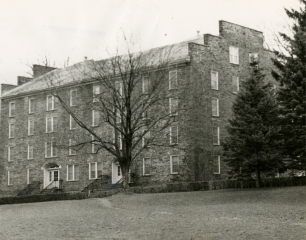that no discord occurred among the workmen; nor is it known, that a drop of ardent spirit was used by an individual while employed in the work.”
The new structure, now East Hall, was built of native stone and on the same straightforward lines of West Hall, which it so well balances. It is 100 feet long, 56 feet wide, and four stories high, and originally contained 125 rooms. Though its two furnaces proved defective and stoves had to be provided for each room, the new building exceeded the Board’s anticipations as to cost and appearance. The Trustees also rejoiced that subscribers promptly met their payments to the building fund.
During the 1830’s three faculty members built homes on the campus: Professor Bacon “Claremont” in 1835, Professor Eaton “Woodland Height” in 1836, and Professor Conant “Beech Grove” or “Inwood” in 1838. Like the other buildings of the Institution, they were of native stone, and each was located on a rise of ground surrounded by trees.






